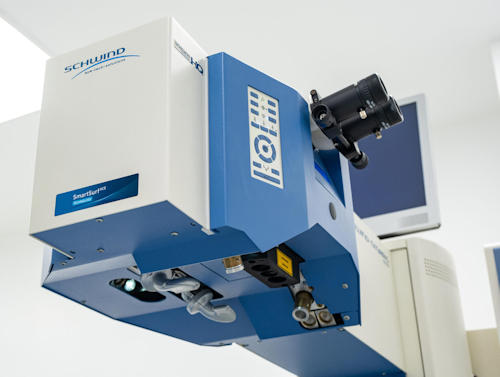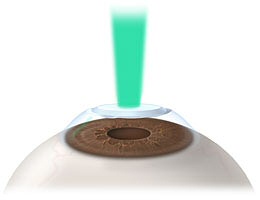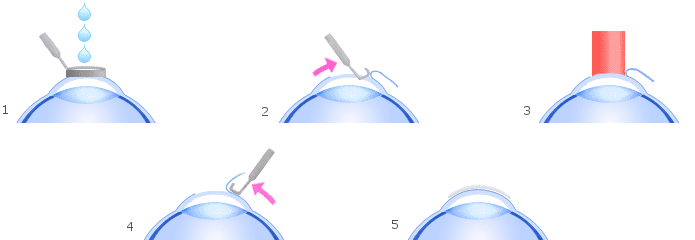
Excimer laser is a type of laser that operates in ultraviolet wavelengths, capable of penetrating to a depth smaller than a micron in the area it hits and separating molecules from each other in that region, thereby eliminating tissue. Due to these characteristics, it is the most suitable physical method for reshaping the outer lens of the eye, called the cornea. It is successfully used in correcting refractive errors such as myopia, hyperopia, and astigmatism.
The procedure is computer-controlled. The laser beam reshapes the corneal surface with very high precision. This brief and painless procedure provides very good results for hypermetropia up to +5, myopia up to -9.5, and astigmatism up to 5 diopters.
The procedure is computer-controlled. The laser beam reshapes the corneal surface with very high precision. This brief and painless procedure provides very good results for hypermetropia up to +5, myopia up to -9.5, and astigmatism up to 5 diopters.
This method is incorrectly referred to as "eye drawing." However, the method of correcting myopia by cutting the cornea into thin slices is called "Radial Keratotomy." Radial keratotomy, which was applied to a group of patients in the 1970s and 1980s, is now a thing of the past.
Wavefront Technology
The lens systems of the eye, namely the cornea and lens, exhibit deviations from perfect refraction called "aberrations" individually and compoundly. Many of these aberrations are regular and can be corrected with glasses. Those that cannot be corrected with glasses lead to our inability to perceive details that the human eye could otherwise perceive clearly.Devices called aberrometers with wavefront technology detect and map these irregularities. Excimer devices that can correct these irregularities by making fewer laser shots in some areas and more in others are considered next-generation devices. Currently, in addition to the ability to correct aberrations in devices, features that do not create new aberrations are also sought after. Systems like Schwind and Esiris, which can perform aspheric ablation, minimize night vision problems for patients.
This technology can be used in LASIK, LASEK, or PRK/t-PRK procedures.
LASIK / Q-LASIK / FEMTOLASIK
LASIK/Q-LASIK is a type of excimer laser applied by lifting a superficial flap with a special device called a microkeratome over the cornea.In FEMTOLASIK, the flap lifted from the cornea is removed with the help of a femtosecond laser.
It is performed under drop anesthesia, and a special device is attached to prevent blinking during the operation. A thin tissue over the cornea is lifted with a microkeratome device or femtosecond. This part, called the corneal flap, is carefully folded aside. Excimer laser treatment is applied to the cornea. After the excimer laser treatment, the removed corneal flap is placed back in its original position, and the operation is completed by applying antibiotic drops. The corneal flap adheres spontaneously and returns to its original state within a few days without the need for stitches. During the first few hours, the patient may experience stinging, watering, and light sensitivity. Clarity of vision occurs after 6-8 hours.

PRK / Trans PRK (No Touch Laser)
PRK is a type of laser that is applied by removing the epithelial layer covering the cornea with special instruments. Trans PRK (No Touch Laser) is a type of laser applied by removing the epithelial layer covering the cornea using excimer laser. It is performed under drop anesthesia, and a special device is set up to prevent blinking during the operation. The epithelial layer on the cornea is removed with a laser. After washing the cornea, excimer laser treatment is applied to the patient. After the excimer laser treatment, a contact lens can be placed on the eye, or it can be left as it is. The epithelial layer heals, especially within the first three days, which can be painful. The cornea renews itself over a few weeks, and the patient may experience blurring of vision for a few days to a few weeks during this period.
LASEK
LASEK is a type of excimer laser where the thin epithelial tissue on the cornea is removed by applying a special alcohol solution without using a knife.It is generally preferred for thin corneas. It is performed under drop anesthesia, and a special device is set up to prevent blinking during the operation. A circular instrument is placed on the cornea to separate the epithelial tissue, and an alcohol solution is dripped inside. The weakened epithelial tissue is removed by lifting the circular instrument. After this process, excimer laser treatment is applied to the patient. After the excimer laser treatment, the removed epithelial tissue is placed back in its original position, and a contact lens is placed on the patient for protection during the healing process. The epithelial tissue returns to its original state within a few days, during which the patient may experience pain and blurring of vision for a few days to a few weeks.

Excimer laser treatment is generally a safe and effective method for suitable candidates. However, it may not be suitable for every patient, and a detailed evaluation is important before treatment.




